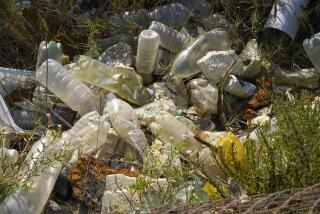Sunlight, Bacteria Enlisted in War on Plastic Trash
Chemists are working on a tough magic act. Theyâre trying to make plastic garbage disappear.
To some extent they have succeeded by creating degradable plastic products such as bags, fast-food containers, six-pack carriers and mulch for farmers.
Photodegradable plastics break down when exposed to the sunâs ultraviolet light. Biodegradable ones rely on microorganisms such as bacteria to make them crumble into fragments or disintegrate completely.
Long chains of hydrocarbon molecules called polymers form most plastics. To make them photodegradable, light-sensitive resins are added. When exposed to sunlight, the chains become increasingly shorter and eventually decompose into tiny bits that can be consumed by microorganisms.
Given enough sunlight, a small fast-food container can break into small fragments in about 50 days.
Seen as Best Answer
Most experts agree that photodegradability is the best way to deal with the plastic litter that proliferates along beaches and roadsides.
âAlmost all leisure trash, even spent shotgun shells left by hunters, can be made photodegradable,â said Richard A. Jamison Jr., president of Ecolyte Atlantic, a Baltimore company specializing in such plastics.
âWeâve had a tremendous amount of interest in our plastics from densely populated places with litter problems such as Japan, Taiwan, Hong Kong and Singapore,â Jamison said.
Concentrating on the biodegradable approach, the St. Lawrence Starch Co., a Canadian firm, has come up with a mixture of corn starch and a vegetable-oil oxidizing agent that shortens polymer chains and can make plastic bags and wrappers fall apart in two or three months.
Greeted With Cynicism
But many people think that although degradable plastics may combat the litter problem, they wonât do much to help communities cope with bulging landfills.
âWe back degradable plastics whenever they serve some worthwhile purpose,â said Susan Vadeny of the Council for Solid Waste Solutions. âBut we donât believe they will alleviate the solid-waste problem in landfills where even paper doesnât vanish. Aggressive plastic-recycling programs and incineration would accomplish more.â
William L. Rathje, an anthropologist at the University of Arizona who has studied landfills in Arizona, California and Illinois, agrees. âPeople envision landfills as glorified compost heaps where everything breaks down and decays,â he said. âNothing could be further from reality. Weâve found 12-year-old newspapers with readable print, vegetables in completely recognizable form, even a complete steak dating from 1972.â
Unlike backyard compost heaps, most landfills are so tightly compacted that the water, oxygen and microorganisms necessary for biodegradation are in short supply and canât freely circulate.
Many companies are betting this situation will change and landfills will eventually become more receptive to biodegradables.
âLandfills of the future will probably be more like giant compost heaps,â said Thomas J. Galvin, an executive with ICI Americas, a branch of a British petrochemical firm. In England, the company has developed a plastic made from bacteria. The plastic turns into carbon dioxide and water when it is exposed to microbes in the soil.
Galvin predicts the new technology will be useful for many products: âAbout 200 million pounds of plastic go into diapers each year and most of it ends up in landfills.â
Landfills--places where trash is highly visible--give the plastics industry a major headache.
Faced with a severe shortage of landfill space, populous Suffolk County, N.Y., has enacted the most stringent law to date. Starting in June, many popular plastic items, including all fast-food containers, will be banned unless they are biodegradable.
âWeâre trying to encourage the plastics industry to rethink some of the wasteful packaging practices that have developed over the years,â said Suffolk County Executive Patrick G. Halpin. âWe hope the measure will encourage recycling and the introduction of biodegradable products.â
Other communities in New York and California have banned certain plastic packaging, and 13 states have passed laws requiring degradable carriers for beverage containers. Similar laws are pending in four other states.
Six-Packs Targeted
At the federal level, the Plastic Pollution Control Act passed by Congress last year requires that all six-pack carriers be made biodegradable by 1990, unless the Environmental Protection Agency finds it is not feasible.
Internationally, the Italian government has decided to ban certain non-degradable plastic bags by 1991, and some other European countries are considering restrictions on various non-degradables.
But plants and equipment worth billions of dollars use existing technology to produce millions of non-degradable products. A sudden large-scale shift to degradables would require an enormous investment.
And so, despite research advances and the pressures of new laws, all plastics wonât soon be part of the disappearing act.
More to Read
Sign up for Essential California
The most important California stories and recommendations in your inbox every morning.
You may occasionally receive promotional content from the Los Angeles Times.










